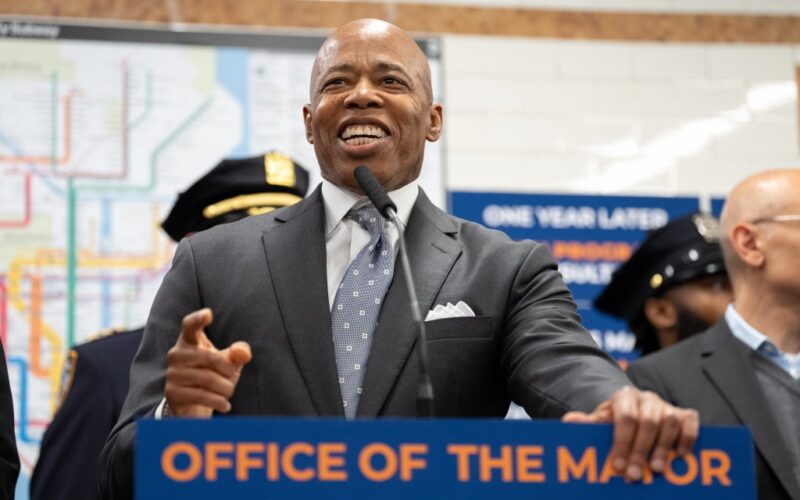More than 6,000 homeless people found sleeping on trains and platforms in the city’s subway system over the last year were helped by a special task force of NYPD cops, nurses and mental health professionals offering shelter and other services, Mayor Adams announced Friday.
Through the one-year-old initiative, known as Partnership Assistance for Transit Homelessness, or PATH, cops and outreach workers have made more than 20,000 contacts with homeless men and women on the subway and provided “tailored support” to 6,100 people, Adams said.
“That could be a hot meal, a bed for the night or a hospital evaluation if they seem at risk of harming themselves or others,” Adams said at the Times Square subway station Friday, with Police Commissioner Jessica Tisch and members of the city’s Department of Homeless Services and Health + Hospitals by his side.
“For far too long, too many individuals have walked past people who couldn’t take care of themselves,” Adams added.
Cops and members of the PATH program conduct inspections of subway stations throughout Manhattan between 8 p.m. and noon the following day. If they see homeless persons in need of help, they offer them a variety of services, which includes bringing them to a shelter or finding them permanent housing.
The program works with Gov. Hochul’s subway safety plan, which has so far brought 8,600 homeless people in the subway to shelters, and found permanent housing for 1,000 people, Adams said.
“All of these fundamental changes have made our city safer for passengers, for everyday New Yorkers,” said Adams, who believes the PATH outreach workers’ assistance has helped bring down transit crime by 17% for the month of September and 4% so far this year.
The PATH teams conducted more than 13,000 train inspections in the program’s first year, Commissioner Tisch said.
“These specially trained NYPD officers have shown a level of compassion and commitment to this work that we haven’t seen before,” she said.
An annual count last January showed that about 4,000 city dwellers were homeless — the most since 2005. About half of the Big Apple’s homeless population live in the subway system.
While seeing the homeless on the subways and in the stations can lead to a perception of crime and violence, some homeless have been arrested for random attacks on the rails.
In April, cops arrested homeless ex-con Lateef Green, who is accused of stabbing a 21-year-old man with a knuckle knife in an unprovoked attack on a Bronx subway train, cops said.

Barry Williams/ New York Daily News
Aaron Walker is pictured in police custody leaving the NYPD Transit District 4 stationhouse on Sept. 24, 2025. (Barry Williams/ New York Daily News)
Last month, Aaron Walker, another homeless man, was arrested on attempted murder charges for sucker-punching and shoving an off-duty cop onto the tracks at the L train station at Third Ave. and E. 14th St. in Manhattan.
Although out-of-control murder suspect David Mazariegos, who is accused of mercilessly stomping a 64-year-old man to death at the Jay St.-MetroTech station in downtown Brooklyn earlier this week, wasn’t homeless, Adams recalled seeing similar grisly cases during his years as an NYPD transit cop.
“The difference here is that we are not going to sit back and ignore the problem. It’s real,” Adams said, referring to those in the subway system suffering from severe untreated mental illness and emotional troubles. Mazariegos had no listed mental illness, but at least one of the 30 arrests on his record was dismissed because of “mental health reasons.”
The key, the mayor said, is to identify and treat those who need mental health care — not just repeatedly run them through the criminal justice system.
“There are people who need care,” Adams said, “who don’t know they need care and go through the system.”








